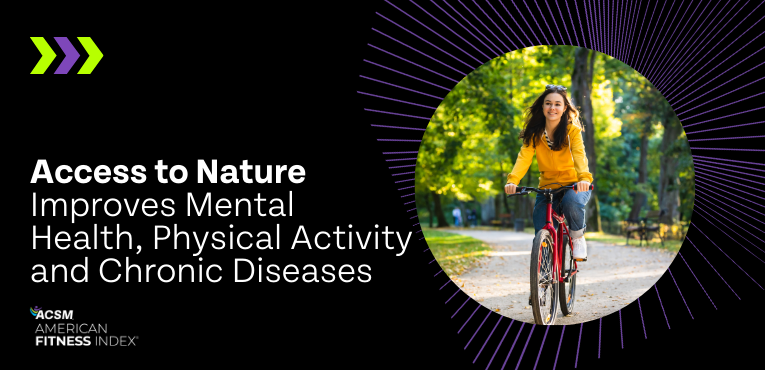Jessie Fudge, M.D., FACSM |
June
12, 2024
 Have you ever wandered to a local park after a long day or a long week, taken a deep breath, and felt stress and tension leave your body? You are not alone. Just 20 minutes per day of exposure to natural environments decreases stress and improves cognitive function, blood pressure, mental health, physical activity and sleep. Chronic stress raises blood pressure and heart rate and is linked to anxiety, depression, heart disease and obesity. The ACSM American Fitness Index 2023 annual report found that, on average, 30% of residents in the 100 most populous U.S. cities have high blood pressure and/or obesity and 10% have diabetes. We know that physical activity can help to prevent and/or treat these chronic conditions. Spending time in nature can too! Some of the best treatments are not found in your local pharmacy.
Have you ever wandered to a local park after a long day or a long week, taken a deep breath, and felt stress and tension leave your body? You are not alone. Just 20 minutes per day of exposure to natural environments decreases stress and improves cognitive function, blood pressure, mental health, physical activity and sleep. Chronic stress raises blood pressure and heart rate and is linked to anxiety, depression, heart disease and obesity. The ACSM American Fitness Index 2023 annual report found that, on average, 30% of residents in the 100 most populous U.S. cities have high blood pressure and/or obesity and 10% have diabetes. We know that physical activity can help to prevent and/or treat these chronic conditions. Spending time in nature can too! Some of the best treatments are not found in your local pharmacy.
Most adults in the United States are not meeting the ACSM and CDC recommendations of 150 minutes of light to moderate intensity activity every week with muscle strengthening added in two times per week. The Fitness Index found that only 50.9% of people in the 100 most populous cities were meeting aerobic activity guidelines and only 23.7% were meeting the guidelines for both aerobic and strength activities. Access to nature and green space can decrease sedentary activity, increase physical activity and have a bonus of decreased anxiety and improved cognitive function.
It is difficult to explain why communing with nature has so many health benefits – is it the fresh air, cool breeze, sights and sounds? Or the increased physical activity that often happens when outdoors? I think it is a little bit of both. One study compared individual responses to different levels of nature by looking at an individual’s pre and post exposure stress levels after visiting a natural setting, a built urban municipal park and a local fitness facility featuring an indoor track and free weights. Levels of cortisol (stress hormone) decreased the most in the natural environment setting. The stress reduction response appeared to be dose dependent with both the natural environment and urban environment providing visitors a decrease in stress through less demands and worries and increased levels of joy. The indoor track provided decreased demands and worries but no change in joy. Moving is good for you. But moving in a natural or outdoor urban environment is even better.
In the cities ranked by the American Fitness Index, an average of 71.5% of residents live within a 10-minute walk to a park. Only 38% percent of people in Louisville, Kentucky live within a 10-minute walk to a park and the city also ranks among the worst 10 cities for elevated blood pressure, heart disease, diabetes, asthma and obesity. While the cause of these chronic conditions is multifactorial, all of these Fitness Index indicators can be improved with increased physical activity and access to nature or parks. Arlington, Virginia was named the fittest city in America for the sixth time! In contrast to Louisville, 99% of Arlington residents live within a 10-minute walk to a park. They also had the highest percentage of residents exercising in the last 30 days and the lowest percentage of residents with diabetes.
Find your nature prescription! Seven out of 10 people can walk to a park within their city. Active transportation, like walking, biking and running, is also a great way to incorporate physical activity and the outdoors into a busy day. If you need help finding your nearest park or walking/biking trail, check out AllTrails. Thirty percent of people have less access to a park within their city. Encourage your community leaders and city officials to incorporate green spaces, walking trails and recreation opportunities into new and existing developments.
I challenge you to at least 20 minutes in nature every day while meeting exercise guidelines for long term mental and physical health.
Author: Jessie Fudge, M.D., FACSM
Originally published on July 31, 2023